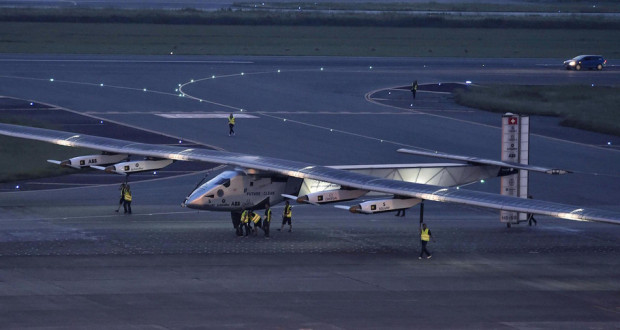-
Tips for becoming a good boxer - November 6, 2020
-
7 expert tips for making your hens night a memorable one - November 6, 2020
-
5 reasons to host your Christmas party on a cruise boat - November 6, 2020
-
What to do when you’re charged with a crime - November 6, 2020
-
Should you get one or multiple dogs? Here’s all you need to know - November 3, 2020
-
A Guide: How to Build Your Very Own Magic Mirror - February 14, 2019
-
Our Top Inspirational Baseball Stars - November 24, 2018
-
Five Tech Tools That Will Help You Turn Your Blog into a Business - November 24, 2018
-
How to Indulge on Vacation without Expanding Your Waist - November 9, 2018
-
5 Strategies for Businesses to Appeal to Today’s Increasingly Mobile-Crazed Customers - November 9, 2018
Flying without a drop of fuel
“Every hour of this flight has been different”.
Advertisement
7212 km was covered by Solar Impulse 2 in the Japan to Hawaii leg, fully on solar energy.
Upon landing, Solar Impulse 2 successfully completed its most challenging stretch of its journey: a nonstop flight of five days and nights from Japan to Hawaii.
Departing from Abu Dhabi in March, the explorers are not on this endeavor for the sake of it, as mankind is facing a much bigger problem with pollution, depletion of natural resources and climate change.
Pilot André Borschberg, also co-founder of Solar Impulse with Bertrand Piccard, broke the world records of distance and duration for solar aviation, as well as the world record for the longest solo flight ever, (117 hours and 52 minutes), around 7,200km.
The Swiss pilot’s arduous journey was by no means in the lap of luxury.
After crossing the Atlantic, the solar powered plane will stop in either Southern Europe or North Africa, before completing its historic journey in its host city, Abu Dhabi.
During a typical 24-hour flight cycle, the pilot rests eight times averaging between 5 and 20 minutes per day.
“I feel exhilarated by this extraordinary journey”, he said.
When he landed he tweeted “it’s a dream coming true”.
It has 17,000 solar cells and onboard rechargeable lithium batteries, allowing it to fly through the night.
Its wingspan is longer than that of a jumbo jet but it weighs only 2.3 tons – about the same as a auto. Fifteen years ago, he narrowly escaped an avalanche, and then in 2013 he was involved in a helicopter crash, which left him with minor injuries. Borschberg is a mechanical engineer, a ex- Swiss air force pilot, consultant and entrepreneur.
Bertrand Piccard, Chairman of Solar Impulse and the second pilot of the team, said that the flight proved that “nobody now can say that renewable energy cannot do the impossible”.
In 2013, over a period of two months, the dynamic aviation duo made the journey across the U.S.
In addition, throughout the five-day flight, Borschberg took 20-minutes naps to keep the Solar Impulse 2 on course.
Explaining how he coped with the long flight, he said, “I do a lot of yoga and meditation …” Borschberg, all smiles, emerged a short time time later from the cockpit.
Advertisement
Borschberg landed shortly after dawn on Friday at Kalaeloa Airport on the main Hawaiian island of Oahu, finishing his historic flight across the Pacific and flying straight into the record books.





























